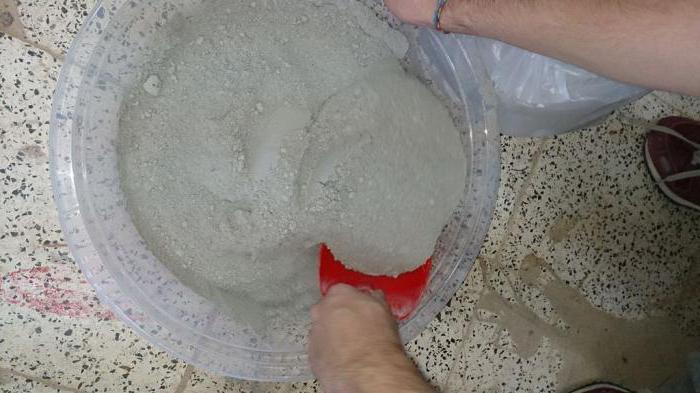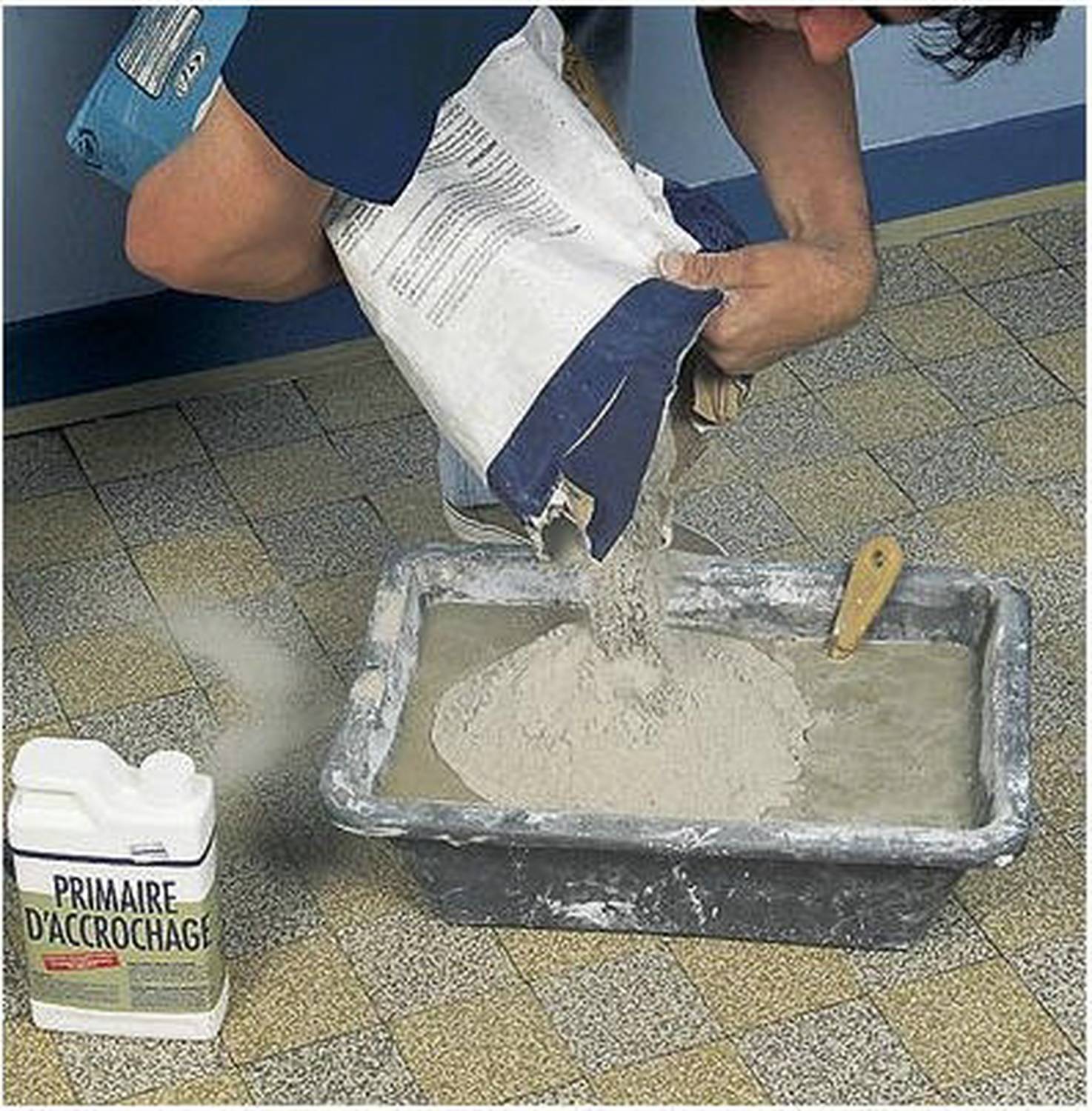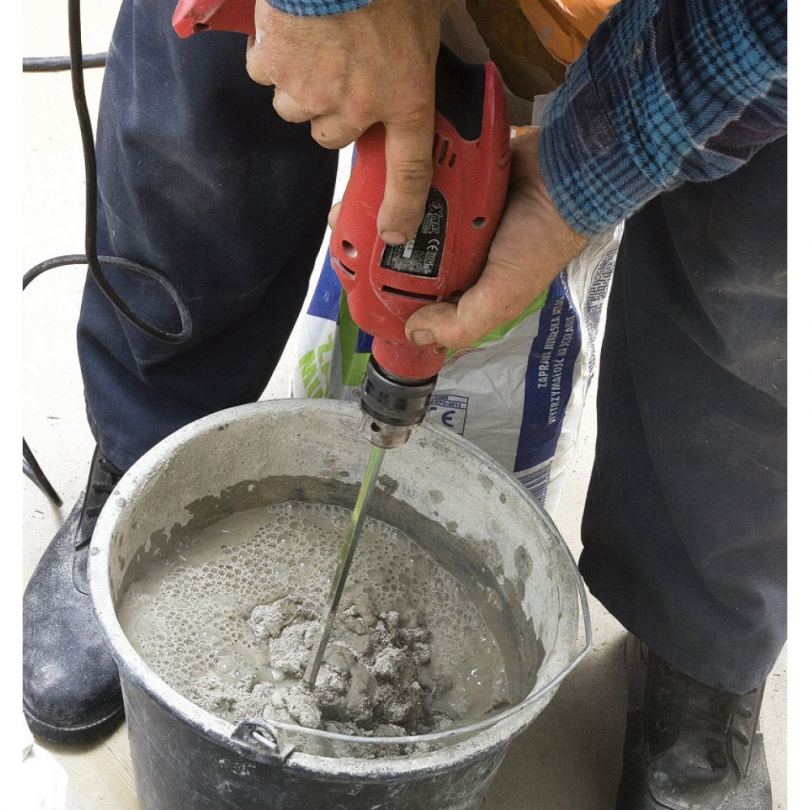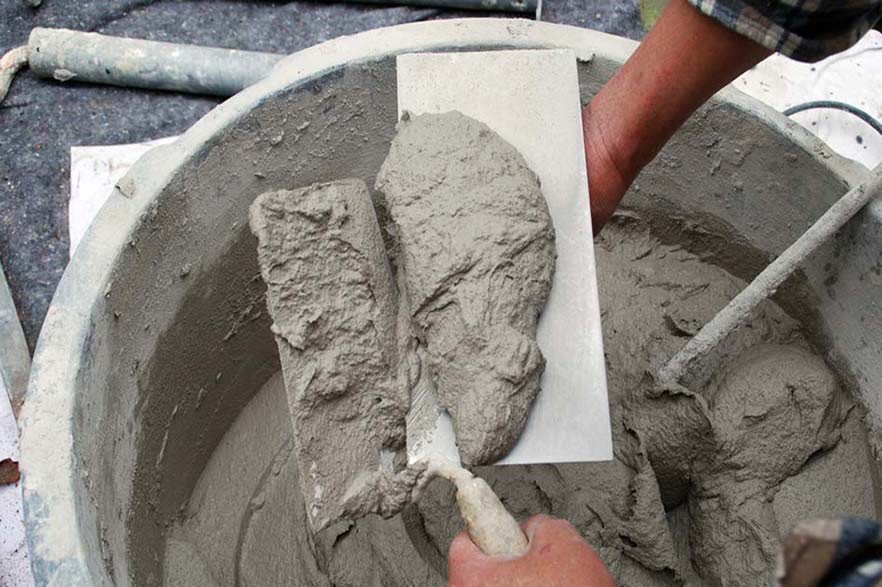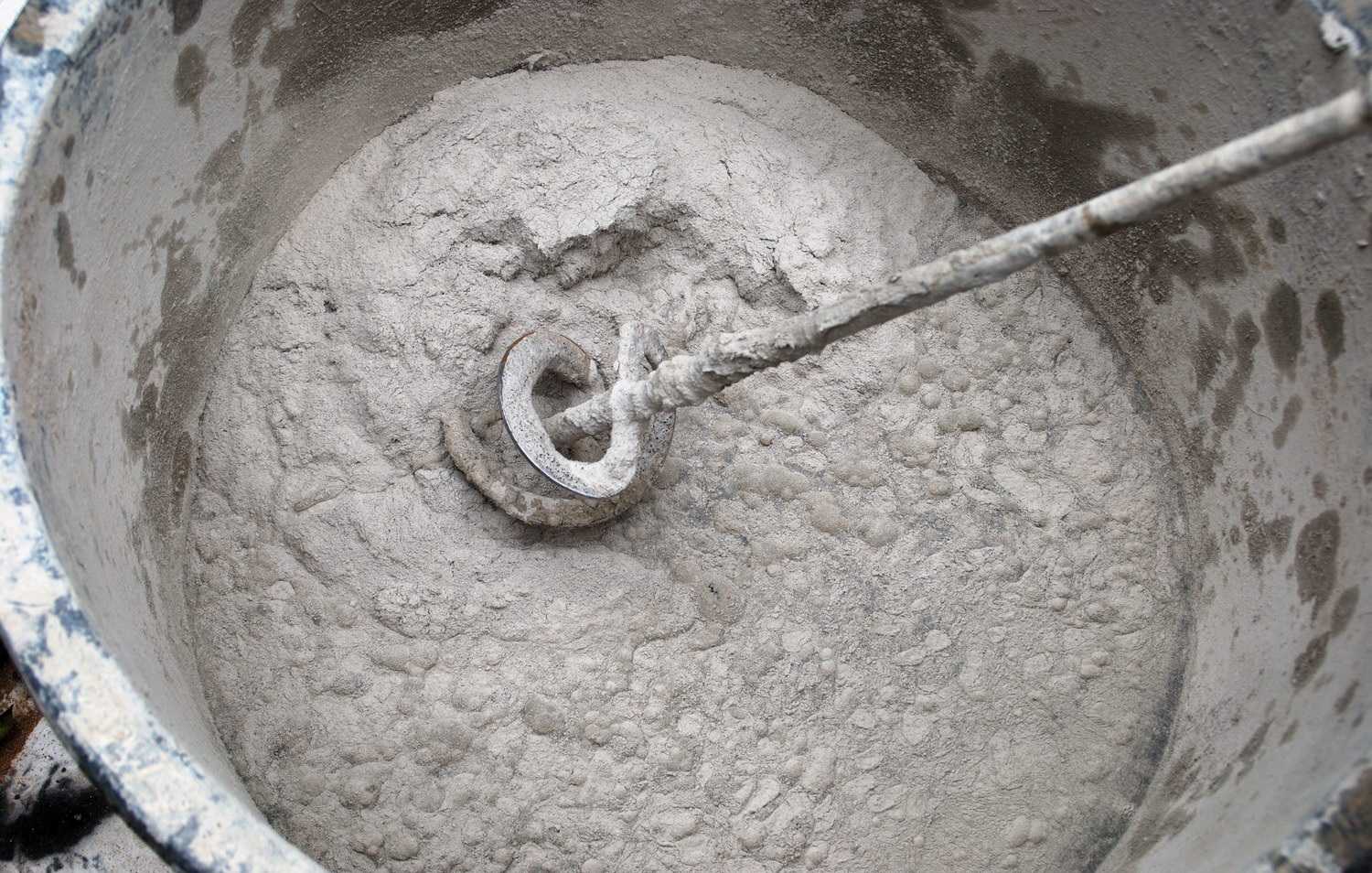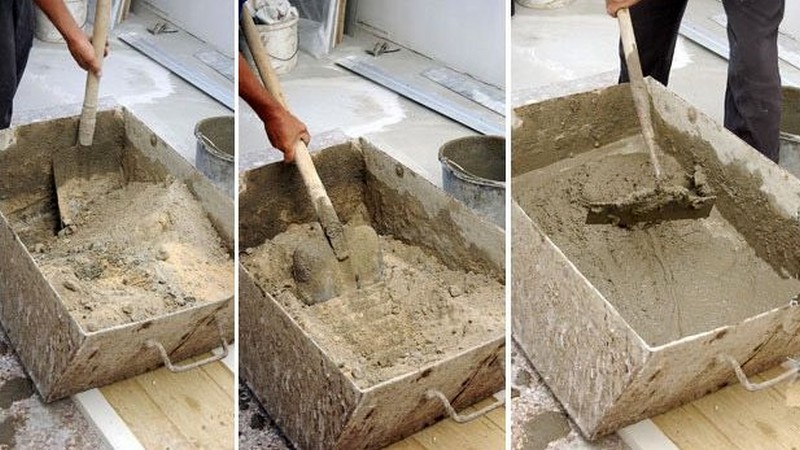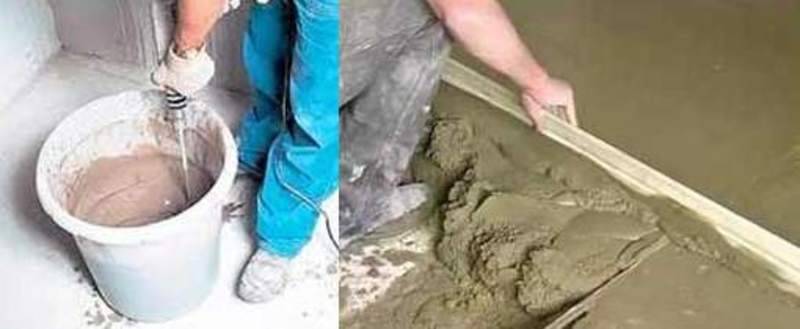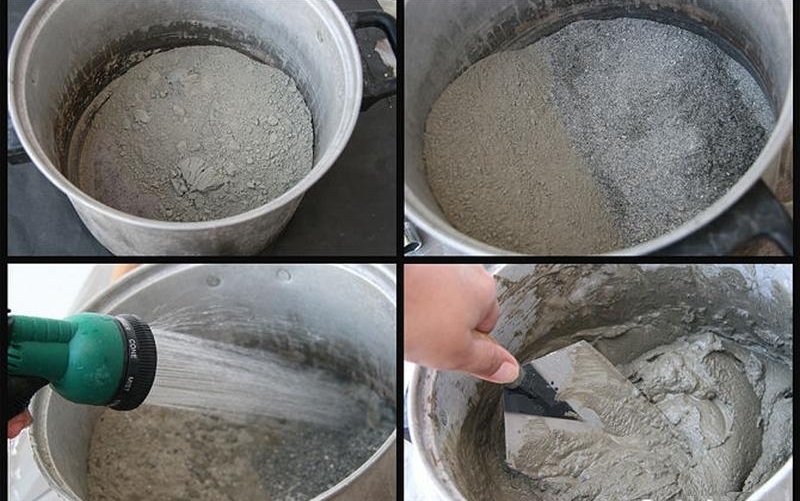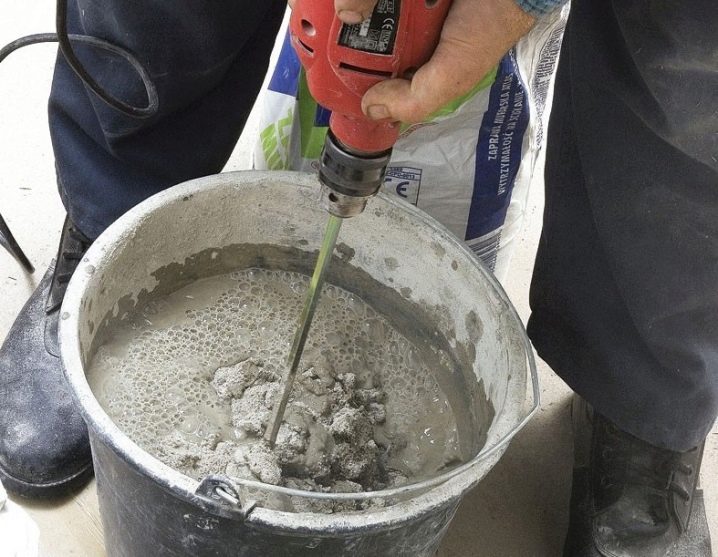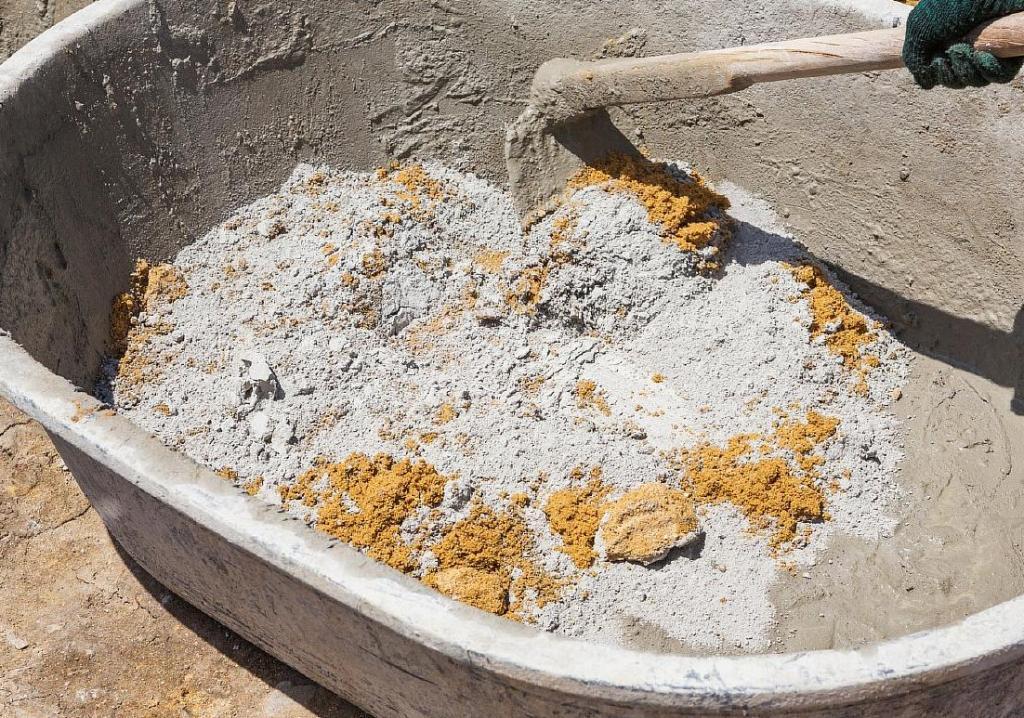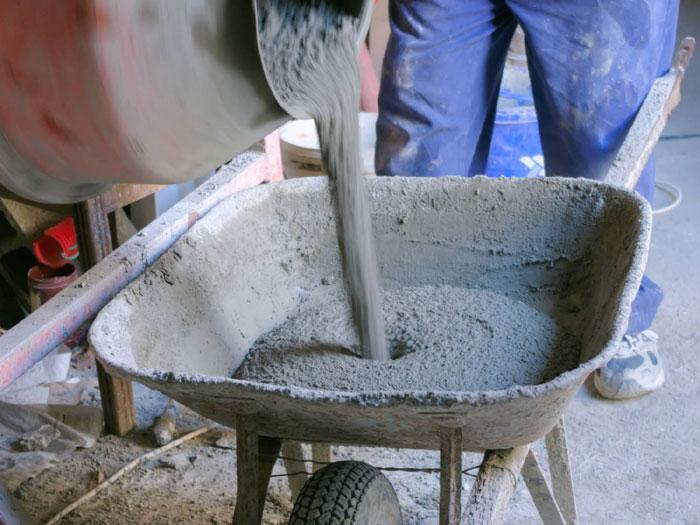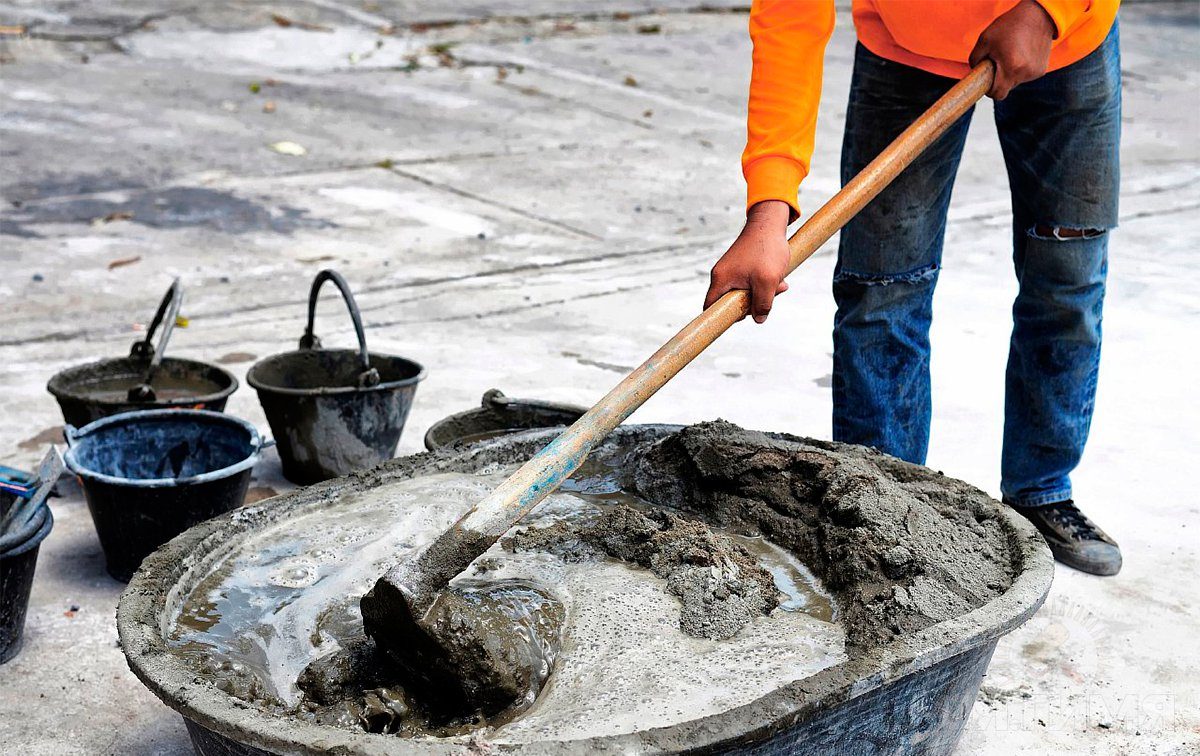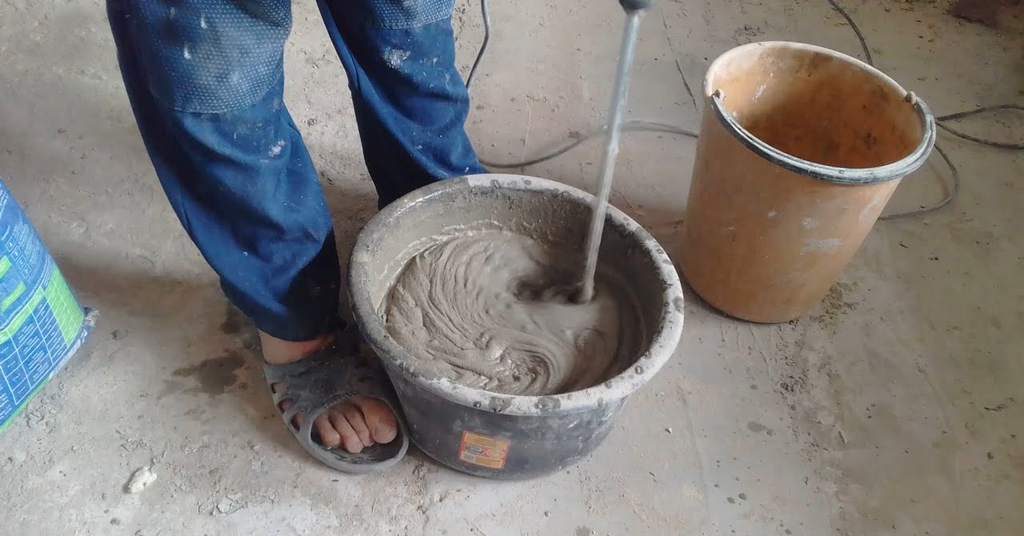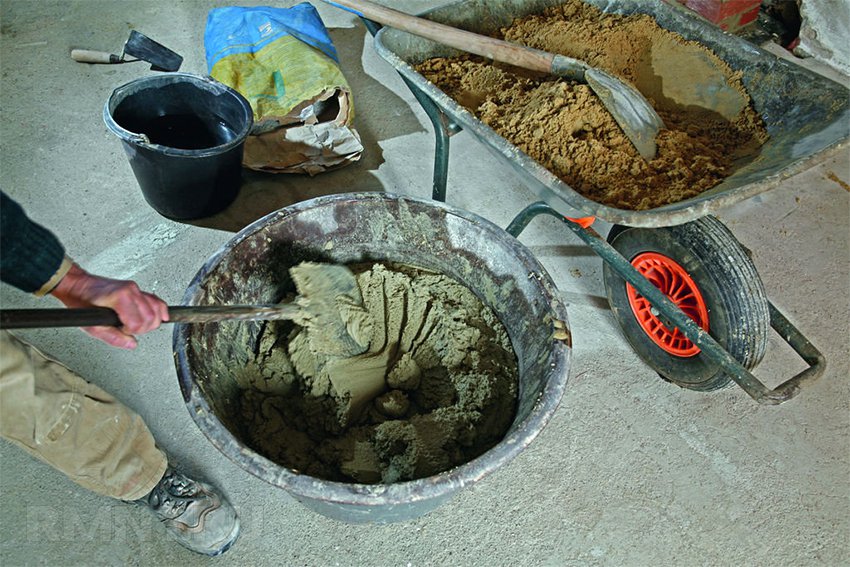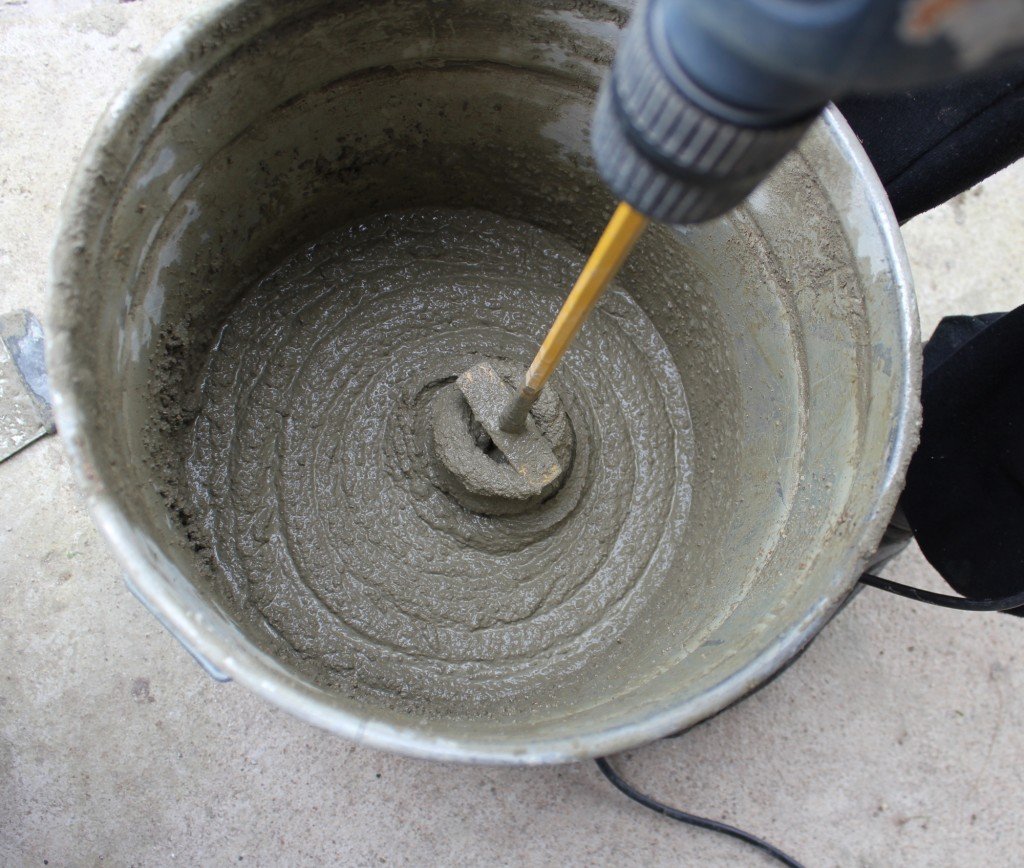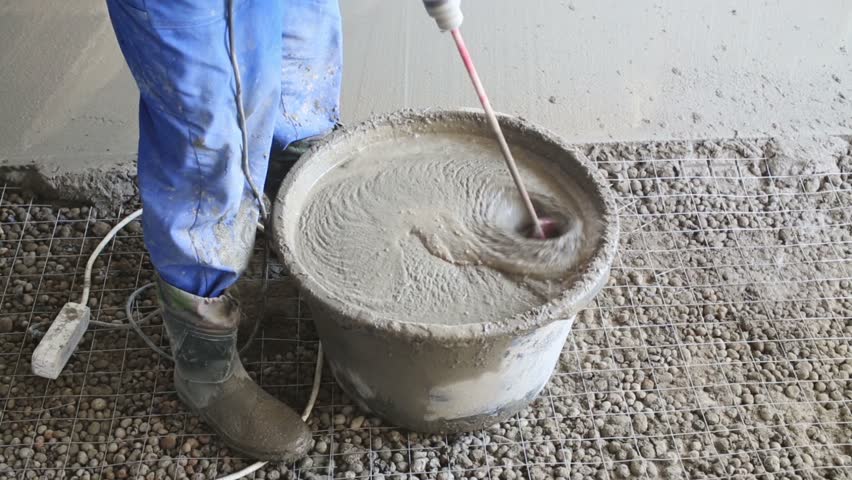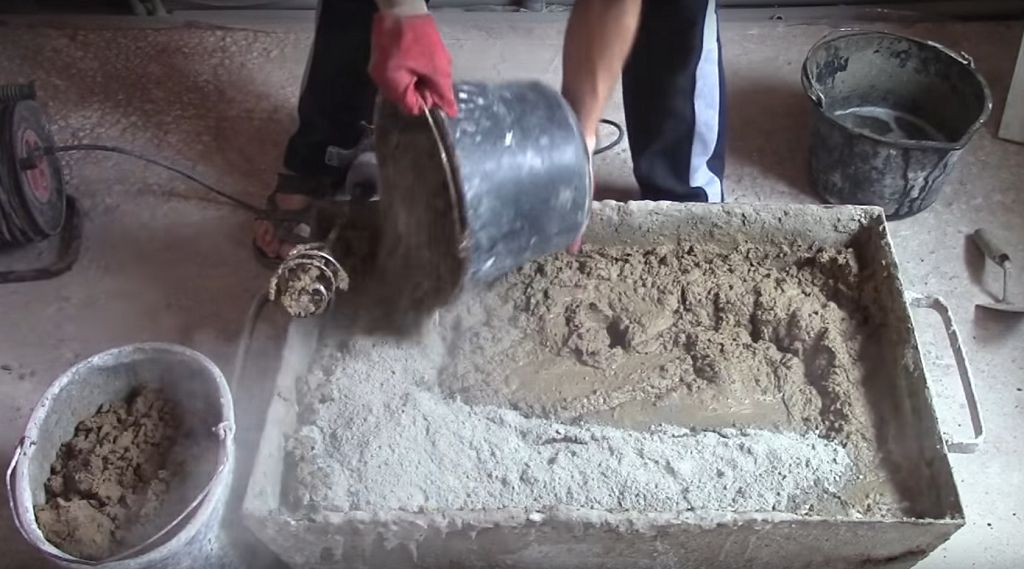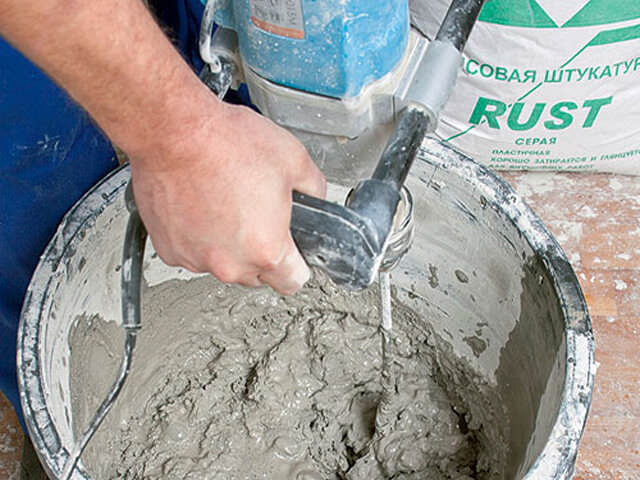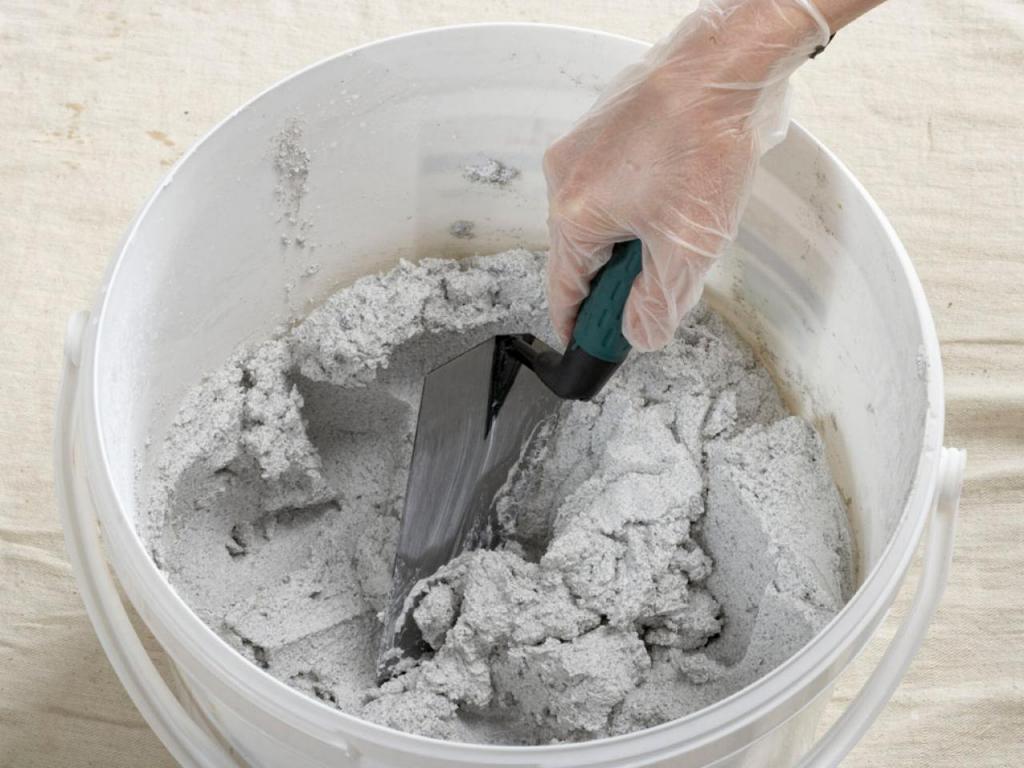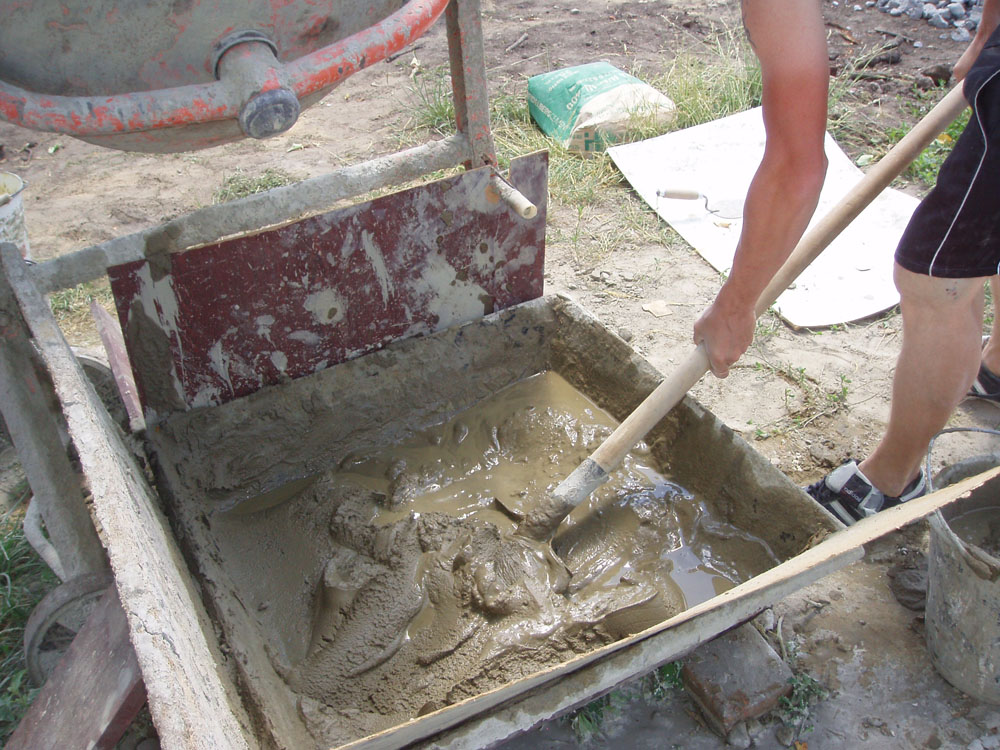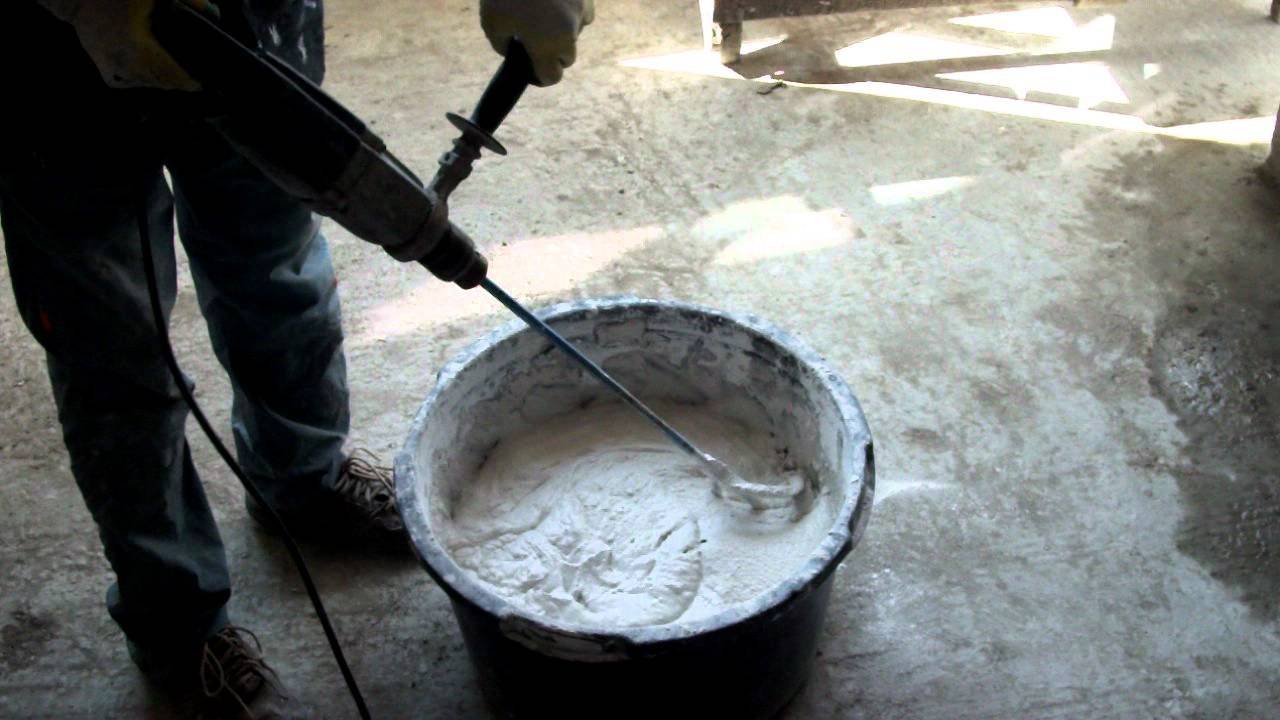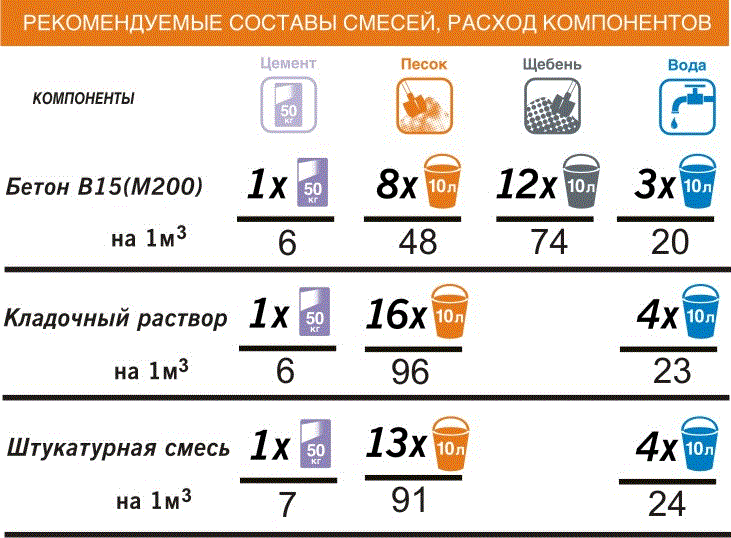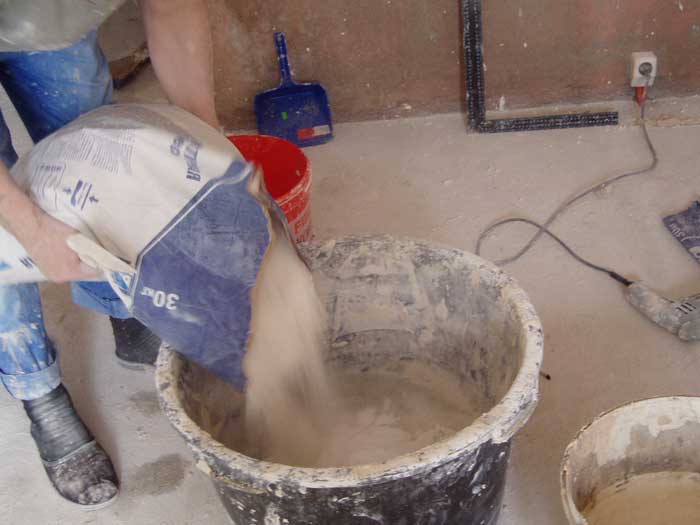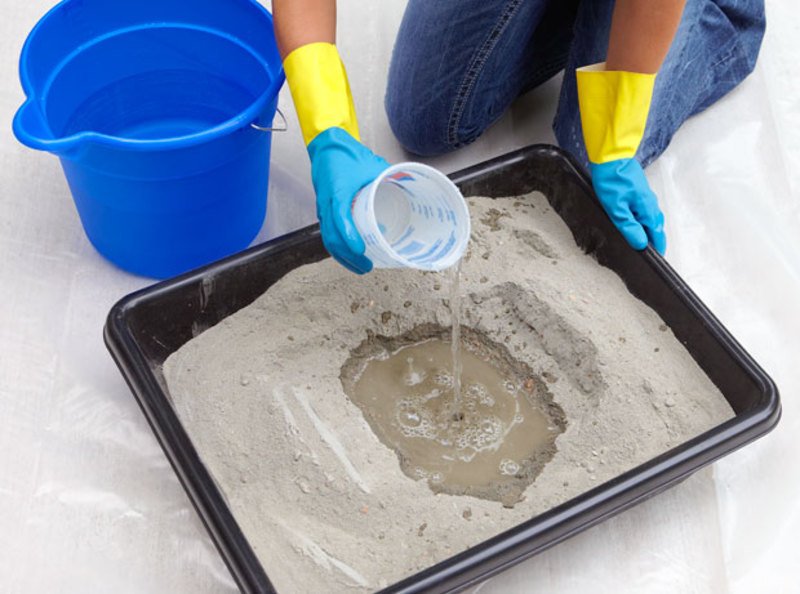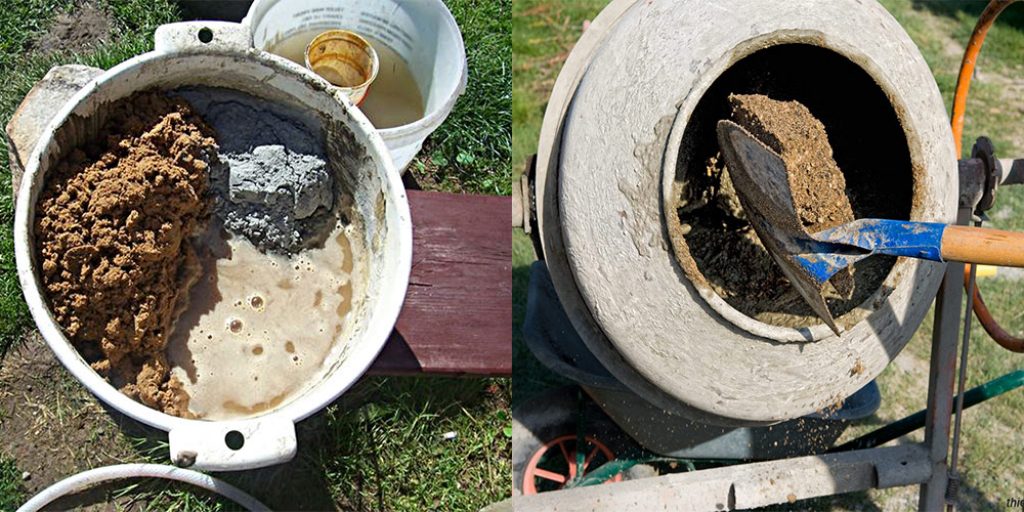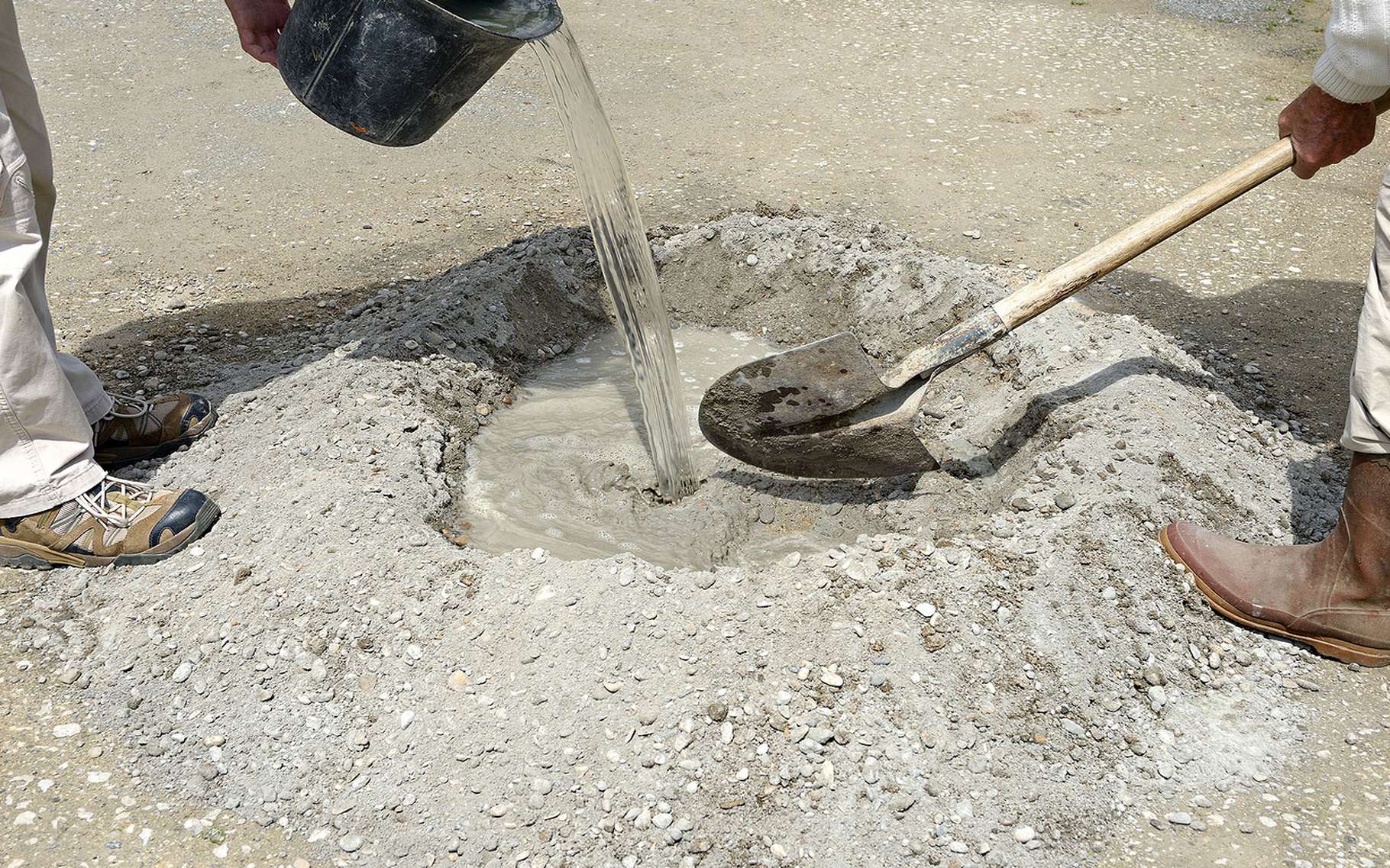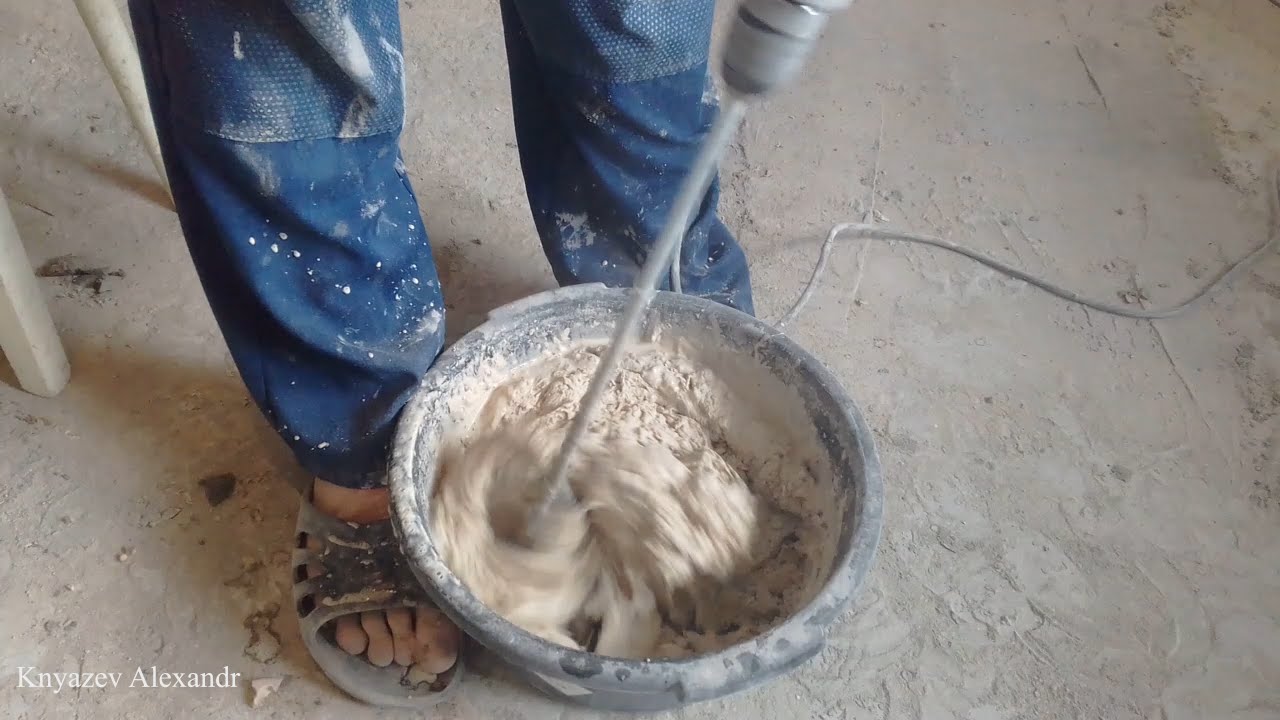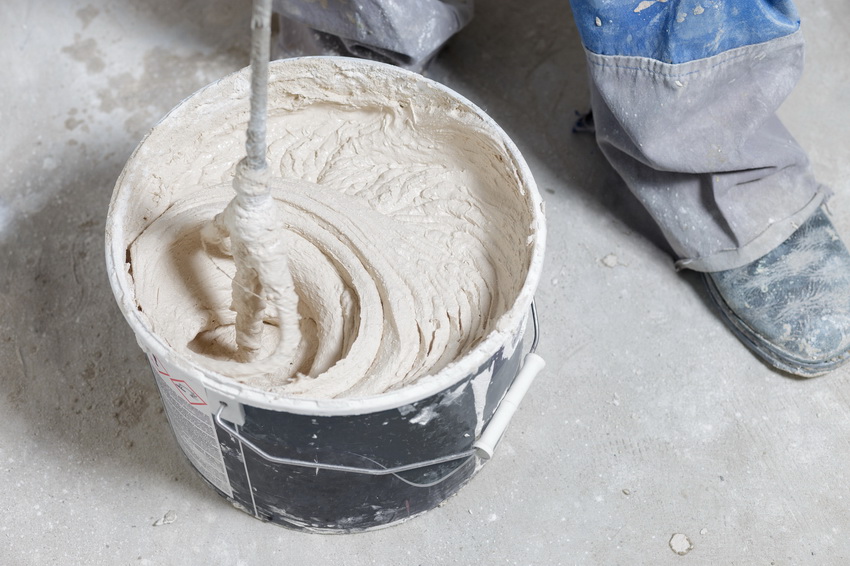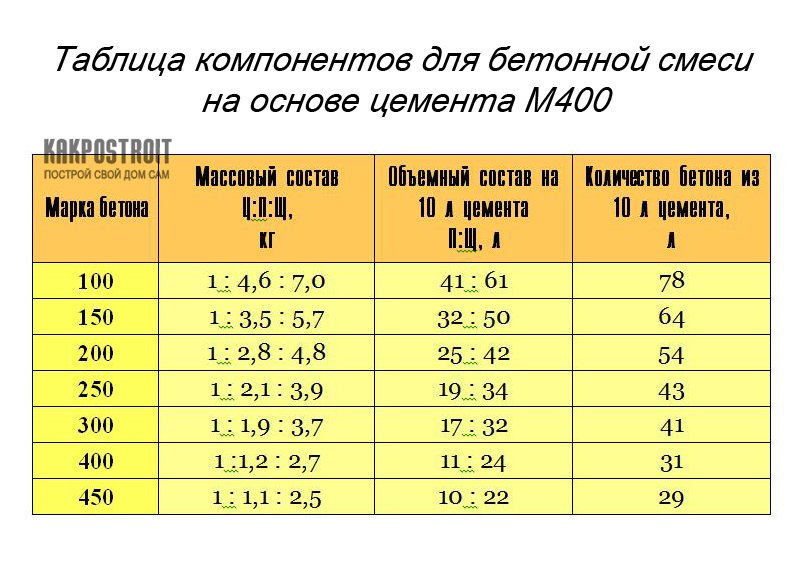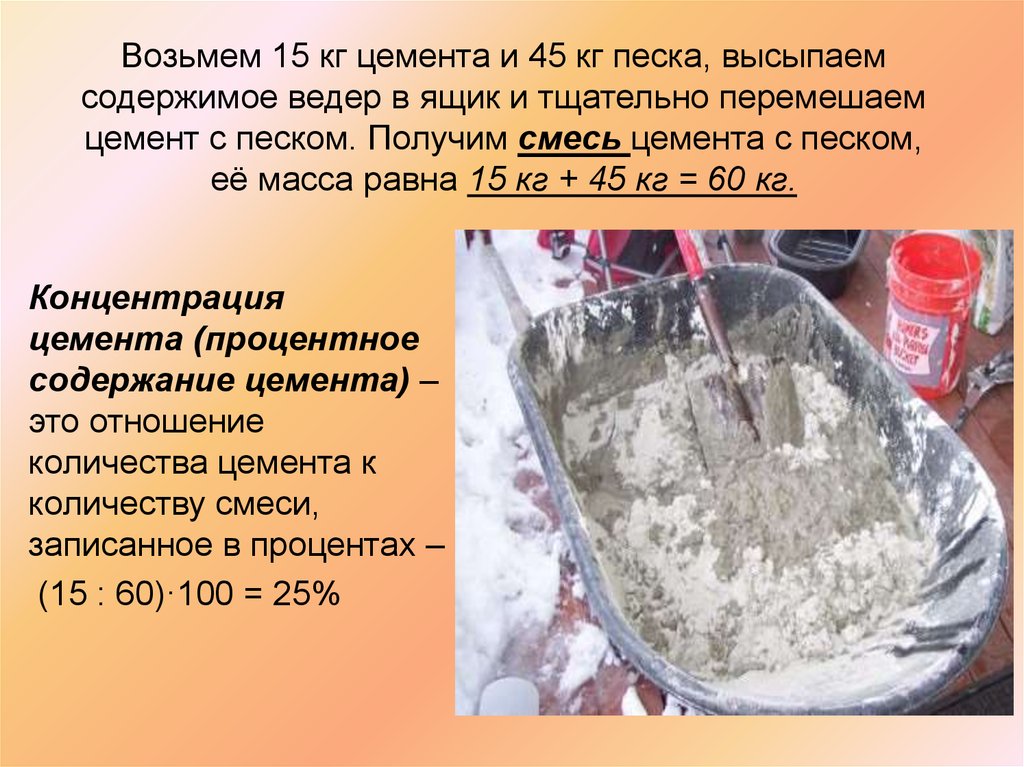Preparation of the solution
So, after all the materials and tools are prepared, you can start making the solution with your own hands.
- 1 layer of cement is poured into the container, then a layer of sand, after which all layers alternate. The number of such layers should be at least 6. Thus, all components can be diluted more efficiently. Sand and cement should be poured into a bed. The total height must be no more than 300 mm.
- The components poured into the container must be mixed several times with shovels until a homogeneous mass is obtained. Do not forget that the quality of the finished mixture and further work will depend on the mixing process. After everything is mixed correctly, experts recommend sifting the composition through a sieve with 3x3 mm cells again. The homogeneous mass must be absolute.
- After mixing the dry components, you cannot immediately add water or other components, for example, water glass. The addition of liquid should be done gradually and carefully. Water must be added very slowly, so you can control the process of acquiring the desired consistency density. If the supply of liquid is large, it is the gradual addition that will not allow the mass to become too liquid.
An equally important indicator for cooking is the temperature of the liquid: it should not be either low or high. Try to use water that is close to the ambient temperature. An important role is played by the ambient temperature: it is necessary to dilute ready-made cement mixtures at an air temperature of at least +5 degrees.
As for the consistency of the cement mortar, everything here will depend on the area in which it will be used. For example, thick material is required for masonry, liquid material for filling.
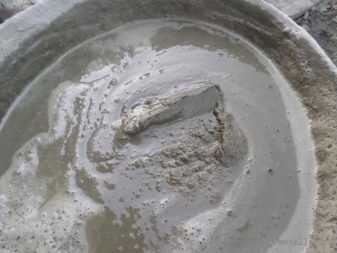
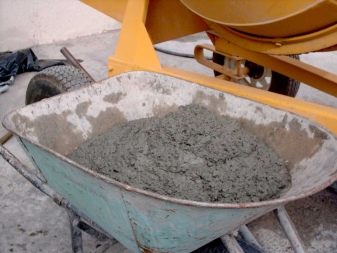
For screed
The rules for preparing the solution depend on the purpose for which it will be used. For example, it is easier to prepare a mixture for a screed than for organizing a foundation. Crushed stone is not required here, and the proportions of the remaining components will be as follows: cement of the M400 brand and sand in a ratio of 1 to 3.
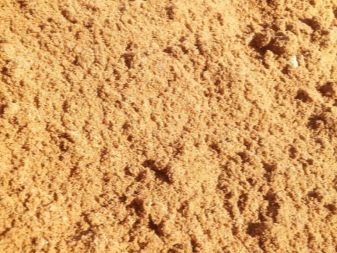
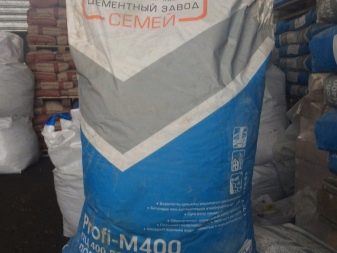
To properly prepare the consistency, follow the steps in the following order:
- lay a sheet of metal on the floor;
- pour 1/3 of the sand and 1/3 of the cement onto the surface, mix until smooth, repeat this action until the ingredients run out;
- make a pile from the resulting dry mixture, and in it a notch;
- Pour some water into this "container" and mix everything well.

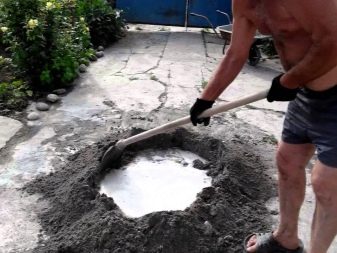
For the foundation
As for the preparation of the mixture for the foundation, the process is more complicated here, and the best solution would be to use a device such as a concrete mixer.
The kneading process is started by adding water. Determine the required amount at a ratio of 1: 4. Experts recommend initially pouring less water, since you can add it at any time
During the preparation of the cement mixture for the foundation, it is very important to monitor the consistency. It is better that it is liquid, but water must be used carefully
If there is a need for density, this indicator can be achieved after the kneading process is completed.
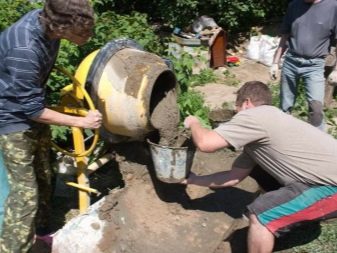
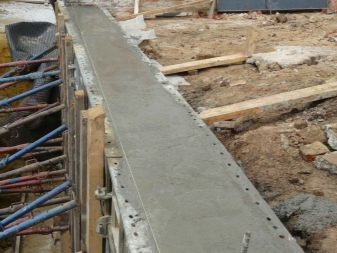
For finishing
The cement mixture is also used for interior decoration. The need for it appears when it is required to carry out high-quality plastering of the surface.
The use of the components that are in the composition of the cement makes it possible to obtain the required consistency
Note that more solution is needed for this to work.If there is a need to sand a small area, you can use manual mixing, but in any case, the concrete mixer will make this process faster.

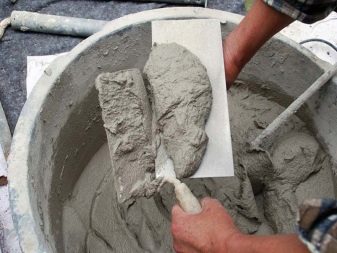
Useful Tips
When planning to dilute the putty for carrying out external or internal work to level the surface of the walls and ceiling, you need to know some of the nuances due to which the process of preparing the mass and working with it will be easier and faster.
All containers and tools must be clean so that they do not have traces of dirt or particles of other building material. All additives will cause the putty to harden more quickly and be difficult to work with. You need to wash everything, and knead a new portion of the mixture, otherwise the dried lumps will damage the finished surface.
The optimal amount of solution is considered to be that which will be enough for a half-hour working process, otherwise the putty will begin to dry out and it will be very difficult to apply it. By making the mixture too thick, its service life will be significantly reduced. A very thin solution will spread on the wall, leaving streaks and stains that are difficult to remove.
If the solution is prepared, settled and mixed again, then no ingredients can no longer be added to it.
It is possible to mix without a mixer using a medium-width spatula for mixing
If water is poured with an electric appliance for mixing, and then putty is poured, then in the manual version the opposite is true. After pouring a certain amount of putty, it is necessary to add a small amount of water to it
Building materials are renewed annually; powder versions of putties are replaced by pasty ones, which are sold ready-made. You can and should use them, the main thing is to choose a trusted manufacturer, look at the date of manufacture and, if necessary, dilute a little with water.
The cost of such products is much higher, but there are no costs for preparing the mixture, you do not need to have additional inventory with you and the work process can be started from the moment the container itself is opened.
The starting putty has the function of a surface corrector, therefore it is often applied in a thick layer. To make it more convenient to work, the work is carried out in two stages. The first involves grouting all cracks and irregularities and preliminary processing of the wall, and the second already more carefully hides all the flaws and forms an even canvas
The finishing putty is applied in a thin layer, and after using it, the walls are rubbed, finally leveling.
Other popular recipes and proportions
The following proportions are generally accepted for making concrete at home: 1 (C) / 4 (U) / 2 (P) / 0.5 (V). In terms of weight, it looks like this: 300/1250/600 kg, water - 180 liters.
If you take cement M400, you get concrete M250, if cement is M500, then the solution is M350. For low grade mortars, the cement content must be reduced. For solution B20 (M250) there is another recipe: 1 (C - M500) / 2.6 (P) / 4.5 (S) / 0.5 (B) or in kg: 315/850/1050, water - 125 liters per cubic meter m.
More proportions (cement: sand: crushed stone; water - half of the cement):
- 1: 3.5: 5.7 - M150 (for floors, tracks);
- 1: 2.8: 4.8 - M200 (fences, foundations of garages and baths);
- 1: 1.9: 3.7 - M300 (walls, strip foundations);
- 1: 1.2: 2.7 - M400 (very strong, professional, quickly sets and hardens).
A simple secret
There is a simple way to determine the proportions. Crushed stone is poured into an empty bucket and evenly distributed. Water is added with a measuring container (1 liter jar) until its level is equal to the edge of the rubble. The volume of liquid is the required volume of sand.
Further, crushed stone is poured, in its place is filled with the same jar of sand of the same amount as there was water. Then water is poured again until it covers the sand. This is how the required volume of cement is determined. The last component is water, its amount is 50-60% of the cement.
The method is based on the principle that sand fills the voids between gravel stones, and cement - between grains of sand.In this case, the strength of the solution will be approximately the same as that of crushed stone. This method does not take into account the spreading of the filler grains, some other parameters, but it is simple, it can be used for non-critical structures.
Choice of cement and proportions
The proportional relationship for concrete mortar depends on the type of future building. How strong should it be, how durable and fire resistant?
Having decided on the type of building and choosing the necessary grade of concrete for it, you need to choose the grade of cement.
| Required concrete grade (according to the project) | Cement brands, in vivo hardening |
| recommended / acceptable | |
| M100 | 300 |
| M150 | 300/400 |
| M200 | 400/300, 500 |
| M250 | 400/300, 500 |
| M300 | 400/ 500 |
| M350 | 400/ 500 |
| M400 | 500/ 550, 600 |
| M450 | 550/ 500, 600 |
| M500 | 600/ 550, 600 |
| M600 | 600/ 550 |
The table shows the regularity that to obtain concretes M150, M200, M250, you need a binder with an indicator that is 2 times higher than the data (for 150 - 300, for 200 - 400).
The most common brands of binder for construction are M400 and M500.
If mixing is carried out manually, the main proportions of preparation for each of the concrete grades are:
when choosing a cement grade M400 -
- for M100 (or concrete class B7.5) - for 1 kg of dry cement there are 4.5 kg of sand and about 7 kg of crushed stone
- for М200 (В15) - for one kilogram of binder - 2.7 kg of sand and 4.7 kg of crushed stone
- for class B22.5 (M300) - up to 1 kg - 1.9 (parts of sand) and 3.7 (gravel)
- for М400 (В30) - 1 kg of binder accounts for slightly more than 1 kg of sand and 2.5 kg of aggregate
when choosing brand M 500 -
- M100 - 1: 5.3: 7.1
- M200 - 1: 3.2: 4.9
- M300 - 1: 2.2: 3.7
- M400 - 1: 1.4: 2.8

Choosing a brand of cement
Example:
With this brand of cement M500, the bag weighs 235 kg. You need to get a concrete grade M300. This means 235 kg - 1. Sand is required 1: 2.2. 235 multiplied by 2.2, we get 517 kg. Crushed stone is needed 1: 3.7 - with a similar calculation, we get 869.5 kg. Water consumption depends on the moisture state of the sand, but the approximate proportion is 1: 0.5 (117.5 l).
If there are no tables:
The approximate ratio of all dry components can be taken - 1: 3: 4. This means that 1 is cement, 3 is sand, 4 is crushed stone. But still, in the construction of load-bearing elements, foundations, it is worth using design coefficients.
In the preparation of more durable concrete grades, they increase the cement consumption
Also pay attention to the criteria of the sand. It is recommended to take river sand as an aggregate: it contains less clay and other impurities
But such sands have the worst adhesion to the solution, since the surface of river grains of sand is smooth. Gully sand, on the other hand, adheres well to the components, but requires preliminary washing.
What mortar is needed for bricklaying
A properly prepared masonry mixture must meet a number of requirements.
Important points:
- selection of the optimal recipe;
- use of quality ingredients;
- preparation of raw materials;
- compliance with cooking technology.
Compliance with technological recommendations and correctly selected proportions of mortar for masonry provide:
- the required plasticity of the working mixture. Compliance with this parameter determines the efficiency of filling irregularities, the absence of voids and cavities in the masonry being built;
- setting duration. It is problematic to use an increased volume of a quick-hardening mixture. Adding lime allows to increase the setting time;
- increased strength properties. After hardening, the strength of the cement mass increases. Brick walls do not lend themselves to deformation due to the high strength of the binder mixture.
Kneading the mixture in an impromptu trough
There is a feature that a mortar for masonry has - the proportions and the ingredients used ensure its transition from the current state of aggregation to the solid. In the process of hydration, strength increases, and the bonding mixture joins the bricks into a single mass. Regardless of what proportions the masonry mortar has, it, without fail, contains the following components:
- binder.When interacting with water, the binder gradually hardens and combines with the remaining ingredients of the working mixture;
- aggregate. It allows you to improve the mechanical characteristics, as well as increase the volume of the masonry mixture;
- water. Water is added to the required consistency, reacts with the astringent component, ensuring the normal course of the hydration process.
Used as an astringent ingredient:
- Portland cement;
- lime;
- lime-cement mixture.
The masonry composition is kneaded on the basis of sifted river or quarry sand. Foreign inclusions in the form of particles of clay, grass or roots are not allowed. The introduction of fiber makes it possible to increase the strength properties of the mixture. The concentration of water affects the convenience of work.
Mortar for laying bricks in a concrete mixer
In addition to the main ingredients, additives are introduced:
- antifreeze components. Prevent water crystallization at negative temperatures, ensure the normal course of hydration;
- plasticizers. Increase the workability of the working mixture, facilitate work with it, and also improve its operational characteristics;
- hardeners. Provide accelerated polymerization of the binder, reduce the duration of curing;
- dyes. The introduction of pigments allows you to change the color gamut of the material, which has a positive effect on the aesthetic perception of the brick wall.
The brand of mortar for brickwork depends on the ratio of the components. With an increase in the proportion of sand, the grade decreases, and with an increase in the proportion of cement, it increases. Various brands are used, of which the most common is M75. In this case, the proportion of cement and sand for brickwork, as well as the amount of lime, is expressed in a ratio of 1: 5: 0.8. Building material with the M75 marking reliably binds various types of bricks and natural stone, ensuring the stability of buildings.
Interesting: Ruukki metal tiles - dismantling together
The proportions of the classic DSP screed
The classic floor screed mortar, as already mentioned, is cement with sand, diluted with water. The proportion (amount of sand per unit of cement) depends on the required strength of the screed and the type of cement used. To make the floor surface durable, use an expensive Portland cement grade M400 and higher.

Proportions of floor screed mortar for M150, M200 and M300 when using different brands of cement
The cheaper M300 can also be used for screed floors in utility rooms. It will go a little more, but there will be savings. For the foundation in a house or apartment under modern coatings, it is better not to take such cement. The rework will require significantly more savings on cement.
What sand to take
It is better to take river sand, and it is washed, of at least two fractions: coarse and medium. Why river? Because it has sharp edges, and this reduces the likelihood that it settles into the lower layers. This is understandable. Why washed? There is a minimum of dust in it. The less dust, the higher the strength of the mortar. The sand also needs different sizes for the mortar strength to be normal.
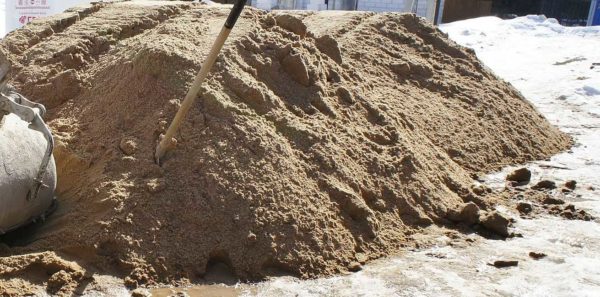
To screed the floor, sand is needed: river washed, two fractions (not fine)
If you are going to lay an expensive coating on the floor with high requirements for the strength of the base (parquet, parquet or engineered board, vinyl tiles), it is better to take just such sand. There will be fewer problems.
Kneading sequence
When making a floor screed solution, first mix the dry components - cement and sand. With manual kneading (in a trough), what to throw in first - cement or sand, there is not much difference. If a concrete mixer is used, they immediately throw in the sand and twist it for a couple of minutes without cement. Then, gradually, cement is usually added with shovels. After each portion, they wait until it is more or less evenly distributed, then throw in the next one. After adding all the binder, mix until a uniformly colored mixture is obtained.
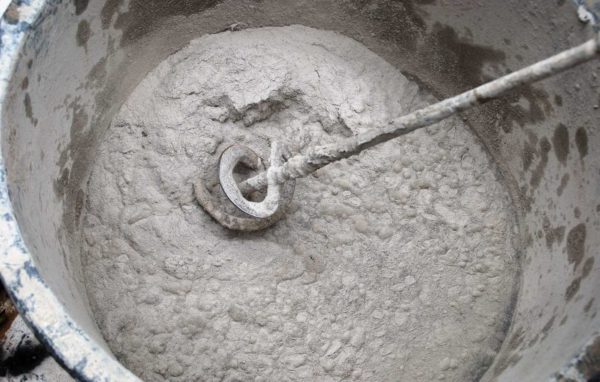
You choose how to prepare the solution: order at the factory / workshop, knead yourself
When the dry components are mixed until a uniform gray mass is obtained, water is gradually introduced. It is counted from the amount of cement. Usually, 0.45-0.55 parts of water are taken for 1 part of cement. Why is it not indicated exactly? Because the amount of water depends on the moisture content of the sand. And it is advisable to pour a minimum of water: this way there will be fewer cracks when drying.
Ready mortar or sand-cement mixture
Those who have at least once mixed DSP or concrete on their own are more likely to buy ready-made concrete. And not a mixture of sand and cement in bags, but concrete from a concrete mixer. Yes, the money is more expensive, but much less time and effort is required. Another plus of this solution: pouring without cold seams. This means less cracks and problems in the future. The next plus is that concrete mixers can deliver the solution to the desired floor. Imagine that you have to drag and drop a couple of tons of sand and cement. Even if there is a freight elevator, it is not easy. It can be costly if you pay the helpers. Climbing stairs "on your shoulders" is generally a problem.
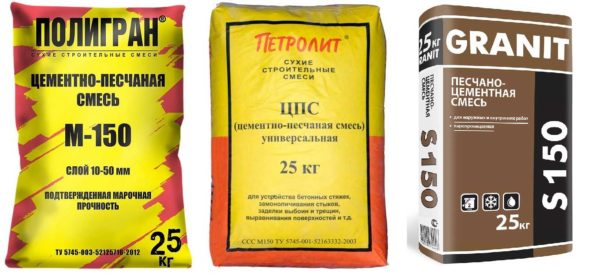
So that you do not care about the proportions of cement and sand, you can buy a ready-made mixture in bags
What are the advantages of buying ready-made sand-cement mixture in bags? In that the proportion is kept exactly, the sand is used in several fractions and in the right quantities. That is, the screed is guaranteed to have the required strength. The downside is the price. You can buy the same amount of cement and sand for a much lower amount. This is if you do not bother with the fractions of the sand. If you take care of this too, then the savings will decrease: not all factions are cheap.
Preparation of cement-sand screed
Floor screed cement mortars are traditional options. Although at the moment there is a wide selection of ready-made compounds on the construction market, self-preparation of the working mixture is still very popular.
The process will need the following set of components:
Cement. The best option is considered to be Portland cement of the M400 and M500 brands. The latter variety is higher in cost, but has a much lower consumption of the composition.
Much attention is paid to the storage time, long periods lead to the loss of the necessary properties.
Sand. It is preliminarily subjected to thorough cleaning by removing foreign inclusions and sieving
It must be borne in mind that the material should not contain impurities.
Plasticizers. The number of components directly depends on what properties you want to get or improve.
Fiber. It is a substance that is used for reinforcement, it replaces the laying of reinforcement or special mesh.
Water. A component for obtaining the desired consistency and finally giving the composition the necessary parameters.
Of course, not all components can be used for work, because the basis of the DSP is cement, sand and water. The purchased plasticizer can be replaced with liquid soap.
Proportions
In view of the fact that the correct mixing of the components used has a great influence on the final result, you should prepare suitable fixtures for measuring.
The proportions of cement and sand for the floor screed, as well as the amount of additional substances, are as follows:
- Work begins with the preparation of dry ingredients. For one part of cement grade M400, it is necessary to prepare 4 parts of sifted sand of the desired fraction. If translated into kilograms, then 1 kg of cement + 4 kg of sand, for a total of 5 kg.
- For the M500 brand, 5 parts are required, a higher indicator reduces the consumption of the main substance.
- Fiber calculation: 1 gram of fiber is added to 1 kg of cement.
- For plasticizers, there is also an optimal indicator, which is 3.8 g per 1 kg of the main component.
- The amount of water is equal to half of the cement used.
Table of solutions according to GOST
But before preparing the composition, it is necessary to determine the total volume, this will make it possible to correctly make the solution for the floor screed.
It is calculated quite simply. The area of the room is measured according to the formula A * B. Where A is the length, B is the width. The result is multiplied by the selected screed thickness in meters, the number of cubic meters is obtained. Due to the fact that the screed is subject to shrinkage, this parameter should be multiplied by a factor equal to 1.2. It should be borne in mind that one cubic meter of cement is approximately 1300 kg, and sand - 1625 kg.
Based on the data obtained, the composition for the floor covering is calculated.
If all proportions are observed, the preparation of the solution by hand is two orders of magnitude slower than the machine method
For example:
The area of the premises is 20 sq. m. Based on the fact that the length is 5 m and the width is 4 m. The estimated thickness of the screed is 50 mm, that is, 0.05 m. It follows from this: 20 * 0.05 = 1 m3. Taking into account the coefficient: 1 * 1.2 = 1.2 m3.
The proportions of sand and cement are 1: 4, the total is 5.
1.2 / 5 = 0.24 m3. The resulting figure is the volume of one part of the cement.
The volume of sand is 0.24 * 4 = 0.96 m3.
From the approximate data, it turns out: 1300 * 0.24 = 312 kg of cement. 1625 * 0.96 = 1560 kg of sand.
Water requires about half the volume of cement, that is, 120–150 liters.
Fiber will need 312 g, plasticizer - about 1100 g.
To prepare a solution at home, it is easier to use traditional methods of weighing ingredients.
Of course, these calculations are approximate, based on the ratio taken, the exact proportions are calculated based on the real situation. For best results, you can use online calculators.
Supplements: Needed or Not?
In a classic floor screed solution, it may be recommended to add plasticizers and fiberglass or other substances for micro-reinforcement. Are they needed or not? First you need to understand what it is and why.
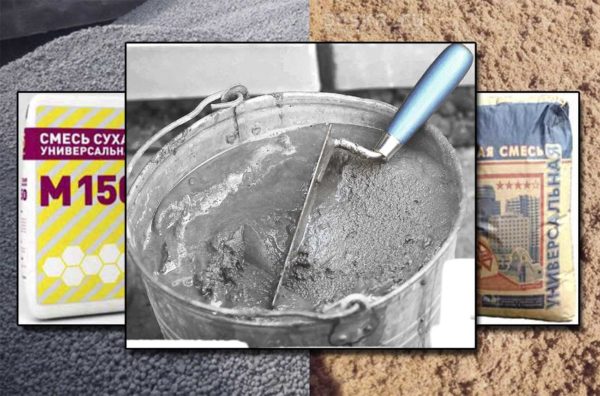
When making a screed solution, you can do only with sand and cement
Plasticizing additives
Plasticizers are substances that increase the plasticity of DSP. It is easier to work with such solutions. Concrete with plasticizer adheres better, smoothes easier, gives a smoother surface. In general, if all the components are of normal quality, well mixed, then it is not difficult to work with mixed water with them. With additives, of course, it's easier. But factory-made plasticizers cost a lot of money, and this increases the cost of the screed. They need to be added in small quantities, but the bill when pouring the floor in the house goes to cubic meters, so the costs will be tangible.
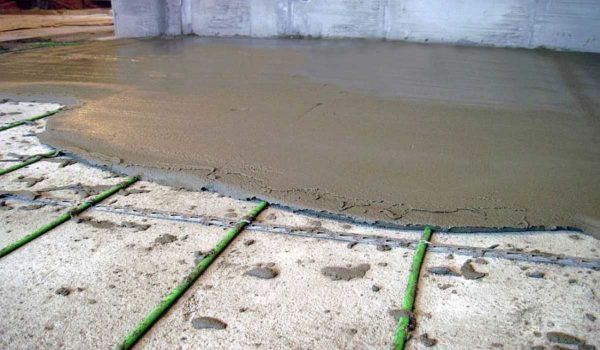
When mixing, the proportions of the solution must be observed with great accuracy. To make the solution fit better, plasticizers are added, and not more water.
As usual, craftsmen have found a replacement for factory-made plasticizers. Ordinary soap is added to the solution. Its consumption is very small - a glass or so for one concrete mixer. The plasticity of the solution increases, so many people use this type of additive. For beginners, it is worth saying: do not exceed the recommended dose. The solution will not get better, but it may well be worse. Soap increases plasticity by "lubricating" the sand, reducing its "adhesion" to the cement slurry. Excessive dosage can lead to a decrease in the strength of the screed. So be specific.
Micro-reinforcement
As you know, when dry, the cement-sand mortar shrinks. The amount of shrinkage is from 1.5% to 3% by volume. Specifically, the percentage of shrinkage depends on the amount of impurities (if the sand is washed, the shrinkage will be less), the correctly selected composition of the aggregate (in this case, sand), the exact proportions and a number of conditions and factors.
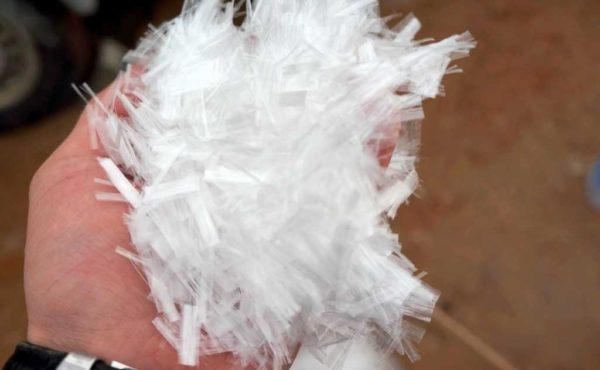
It looks like polypropylene fiber
Everything would be fine, but cracks form in the solution when it shrinks. They are always there, only larger or smaller, more or less. To reduce the number of cracks, micro-reinforcement materials are added to the solution.Fiber is most often used in everyday life. It happens:
- fiberglass;
- basalt;
- metal;
- polypropylene.
The most popular for household purposes is polypropylene fiber. It is the most inexpensive and gives a good result. How does it work? 100 grams of this supplement contains a huge amount of synthetic fibers. They are very thin, but synthetics are highly durable. These fibers are randomly, but evenly distributed throughout the entire thickness of the solution. In concrete, they form a kind of lattice in space. When stresses arise during the drying of the screed, they bind parts of the solution together, reducing the number and size of cracks.
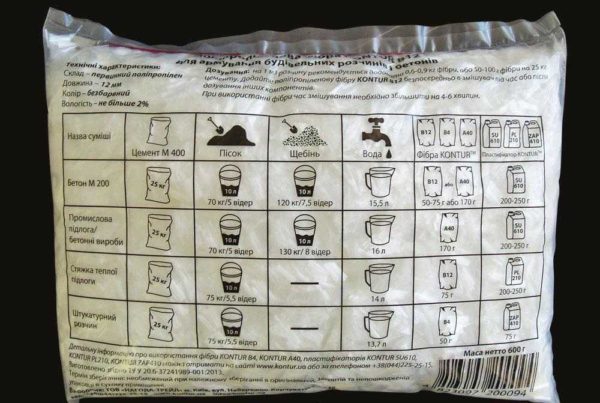
It is important to comply with the supplement norms
The second effect of fiberglass is a smoother and more durable surface. So this screed additive is more useful and definitely worth using. But again, strictly according to the recommendations. It seems that if you add more fiber, there will be fewer cracks, but no. The strength of the screed will decrease.

